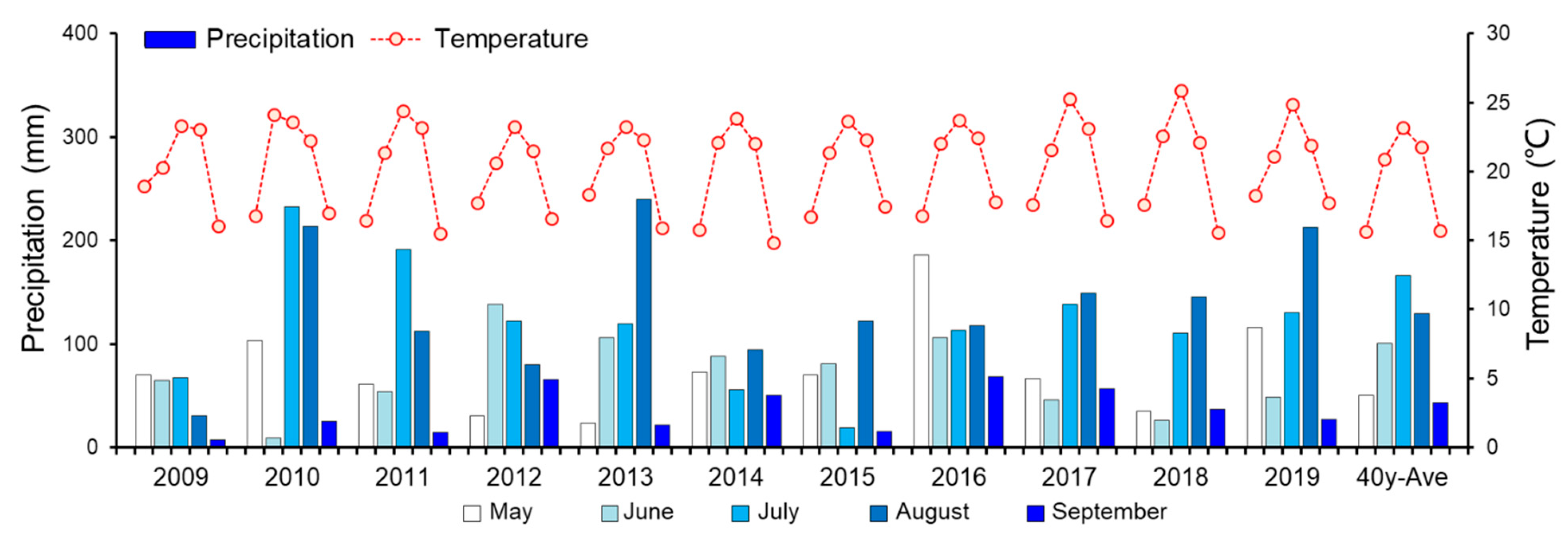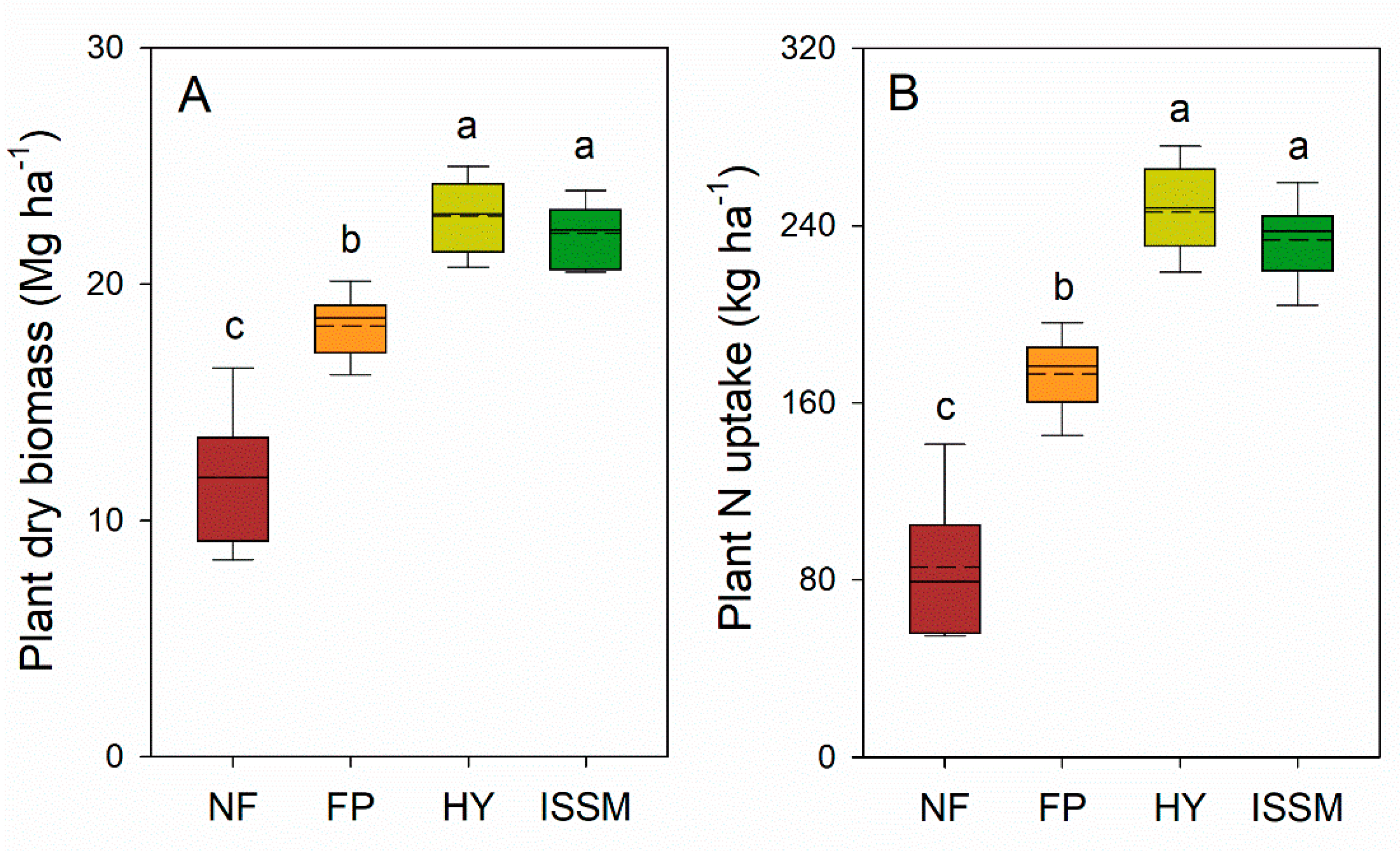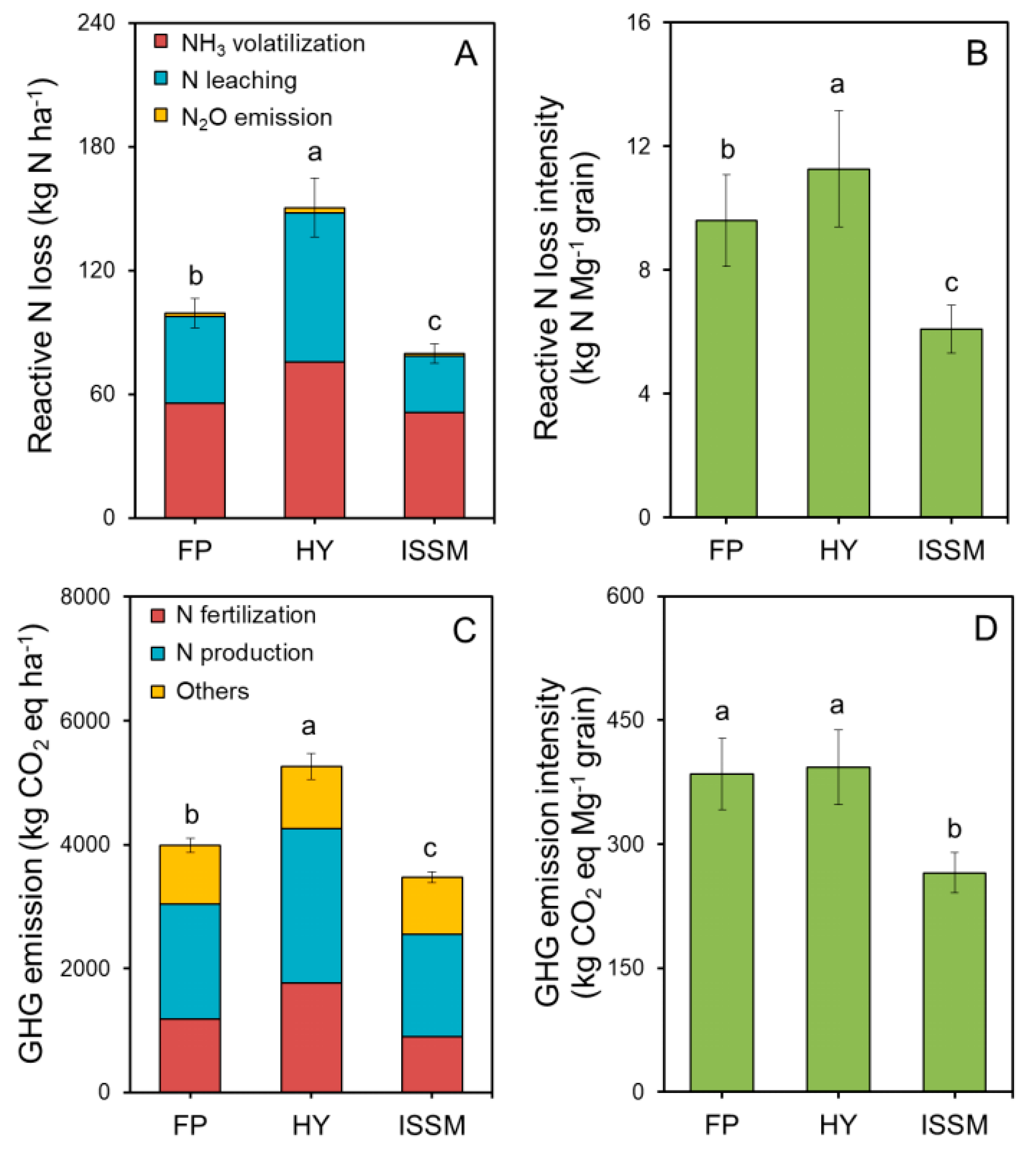Integrated Soil–Crop System Management with Organic Fertilizer Achieves Sustainable High Maize Yield and Nitrogen Use Efficiency in Northeast China Based on an 11-Year Field Study
Abstract
1. Introduction
2. Material and Methods
2.1. Experimental Site and Climatic Condition
2.2. Experimental Design and Management
2.3. Sampling, Measurement and Calculation
2.4. Statistical Analyses
3. Results
3.1. Maize Yield and Yield Trend
3.2. Yield Components
3.3. Plant Dry Biomass and N Uptake
3.4. Nitrogen Use Efficiency
3.5. Environmental Costs
4. Discussion
5. Conclusions
Author Contributions
Funding
Acknowledgments
Conflicts of Interest
References
- Zhang, F.S.; Cui, Z.L.; Fan, M.S.; Zhang, W.F.; Chen, X.P.; Jiang, R.F. Integrated soil-crop system management: Reducing environmental risk while increasing crop productivity and improving nutrient use efficiency in China. J. Environ. Qual. 2011, 40, 1051–1057. [Google Scholar] [CrossRef] [PubMed]
- Cui, Z.; Zhang, H.; Chen, X.; Zhang, C.; Ma, W.; Huang, C.; Zhang, W.; Mi, G.; Miao, Y.; Li, X.; et al. Pursuing sustainable productivity with millions of smallholder farmers. Nature 2018, 555, 3633–3666. [Google Scholar] [CrossRef] [PubMed]
- Xia, L.; Xia, Y.; Li, B.; Wang, J.; Wang, S.; Zhou, W.; Yan, X. Integrating agronomic practices to reduce greenhouse gas emissions while increasing the economic return in a rice-based cropping system. Agric. Ecosyst. Environ. 2016, 231, 24–33. [Google Scholar] [CrossRef]
- Huang, Y.W.; Ren, W.; Wang, L.X.; Hui, D.F.; Grovea, J.H.; Yang, X.J.; Tao, B.; Goffe, B. Greenhouse gas emissions and crop yield in no-tillage systems: A meta-analysis. Agric. Ecosyst. Environ. 2018, 268, 144–153. [Google Scholar] [CrossRef]
- Guo, J.H.; Liu, X.J.; Zhang, Y.; Shen, J.L.; Han, W.X.; Zhang, W.F.; Christie, P.; Goulding, K.W.; Vitousek, P.M.; Zhang, F.S. Significant acidification in major Chinese croplands. Science 2010, 327, 1008–1010. [Google Scholar] [CrossRef]
- Duan, Y.; Xu, M.; Wang, B.; Yang, X.; Huang, S.; Gao, S. Long-term evaluation of manure application on maize yield and nitrogen use efficiency in China. Soil Sci. Soc. Am. J. 2011, 75, 1562–1573. [Google Scholar] [CrossRef]
- Ju, X.T.; Xing, G.X.; Chen, X.P.; Zhang, S.L.; Zhang, L.J.; Liu, X.J.; Cui, Z.L.; Yin, B.; Christie, P.; Zhu, Z.L.; et al. Reducing environmental risk by improving N management in intensive Chinese agricultural systems. Proc. Natl. Acad. Sci. USA 2009, 106, 3041–3046. [Google Scholar] [CrossRef]
- Liu, X.J.; Zhang, Y.; Han, W.X.; Tang, A.H.; Shen, J.L.; Cui, Z.L.; Vitousek, P.; Erisman, J.W.; Goulding, K.; Christie, P.; et al. Enhanced nitrogen deposition over China. Nature 2013, 494, 459–462. [Google Scholar] [CrossRef]
- Ju, X.T.; Kou, C.L.; Zhang, F.S.; Christie, P. Nitrogen balance and groundwater nitrate contamination: Comparison among three intensive cropping systems on the North China Plain. Environ. Pollut. 2006, 143, 117–225. [Google Scholar] [CrossRef] [PubMed]
- Le, C.; Zha, Y.; Li, Y.; Sun, D.; Lu, H.; Yin, B. Eutrophication of lake waters in China: Cost, causes, and control. Environ. Manag. 2010, 45, 626–668. [Google Scholar] [CrossRef] [PubMed]
- Cassman, K.G. Ecological intensification of cereal production systems: Yield potential, soil quality, and precision agriculture. Proc. Natl. Acad. Sci. USA 1999, 96, 5952–5959. [Google Scholar] [CrossRef] [PubMed]
- Chen, X.P.; Cui, Z.L.; Vitousek, P.M.; Cassman, K.G.; Matson, P.A.; Bai, J.S.; Meng, Q.F.; Hou, P.; Yue, S.C.; Römheld, V. Integrated soil–crop system management for food security. Proc. Natl. Acad. Sci. USA 2011, 108, 6399–6404. [Google Scholar] [CrossRef] [PubMed]
- Chen, X.; Cui, Z.; Fan, M.; Vitousek, P.; Zhao, M.; Ma, W.; Wang, Z.; Zhang, W.; Yan, X.; Yang, J.; et al. Producing more grain with lower environmental costs. Nature 2014, 514, 486–489. [Google Scholar] [CrossRef] [PubMed]
- Jin, L.; Cui, H.; Li, B.; Zhang, J.; Dong, S.; Liu, P. Effects of integrated agronomic management practices on yield and nitrogen efficiency of summer maize in North China. Field Crops Res. 2012, 134, 30–35. [Google Scholar] [CrossRef]
- Liu, Z.; Zhu, K.; Dong, S.; Liu, P.; Zhao, B.; Zhang, J. Effects of integrated agronomic practices management on root growth and development of summer maize. Europ. J. Agron. 2017, 84, 140–151. [Google Scholar] [CrossRef]
- Liu, Z.; Gao, J.; Gao, F.; Dong, S.; Liu, P.; Zhao, B.; Zhang, J. Integrated agronomic practices management improve yield and nitrogen balance in double cropping of winter wheat-summer maize. Field Crops Res. 2018, 221, 196–206. [Google Scholar] [CrossRef]
- Zhou, B.Y.; Sun, X.F.; Wang, D.; Ding, Z.S.; Li, C.F.; Ma, W.; Zhao, M. Integrated agronomic practice increases maize grain yield and nitrogen use efficiency under various soil fertility conditions. Crop J. 2019, 4, 527–538. [Google Scholar] [CrossRef]
- Ladha, J.K.; Dawe, D.; Pathak, H.; Padre, A.T.; Yadav, R.L.; Singh, B.; Singh, Y.; Singh, Y.; Singh, P.; Kundu, A.L.; et al. How extensive are yield declines in long-term rice–wheat experiments in Asia? Field Crops Res. 2003, 81, 159–180. [Google Scholar] [CrossRef]
- Cai, Z.C.; Qin, S.W. Dynamics of crop yields and soil organic carbon in a long-term fertilization experiment in the Huang-Huai-Hai Plain of China. Geoderma 2006, 136, 708–715. [Google Scholar] [CrossRef]
- Zhao, B.Z.; Chen, J.; Zhang, J.B.; Xin, X.L.; Hao, X.Y. How different long-term fertilization strategies influence crop yield and soil properties in a maize field in the North China Plain. J. Plant Nutr. Soil Sci. 2013, 176, 99–109. [Google Scholar] [CrossRef]
- Bhattacharyya, R.; Pandey, A.K.; Gopinath, K.A.; Mina, B.L.; Bisht, J.K.; Bhatt, J.C. Fertilization and crop residue addition impacts on yield sustainability under a rainfed maize-wheat system in the Himalayas. Proc. Natl. Acad. Sci. India Sec. B Biol. Sci. 2016, 86, 21–32. [Google Scholar] [CrossRef]
- Meena, B.P.; Biswas, A.K.; Singh, M.; Chaudhary, R.S.; Singh, A.B.; Das, H.; Patra, A.K. Long-term sustaining crop productivity and soil health in maize–chickpea system through integrated nutrient management practices in Vertisols of central India. Field Crops Res. 2019, 232, 62–76. [Google Scholar] [CrossRef]
- Muhammad, Q.; Huang, J.; Waqas, A.; Li, D.C.; Liu, S.J.; Zhang, L.; Andong, C.; Liu, L.S.; Xu, Y.M.; Gao, J.S.; et al. Yield sustainability, soil organic carbon sequestration and nutrients balance under long-term combined application of manure and inorganic fertilizers in acidic paddy soil. Soil Tillage Res. 2020, 198, 104569. [Google Scholar]
- Pan, G.X.; Smith, P.; Pan, W.N. The role of soil organic matter in maintaining the productivity and yield stability of cereals in China. Agric. Ecosyst. Environ. 2009, 129, 344–348. [Google Scholar] [CrossRef]
- Zhang, X.B.; Sun, N.; Wu, L.H.; Xu, M.G.; Bingham, I.J.; Li, Z.F. Effects of enhancing soil organic carbon sequestration in the topsoil by fertilization on crop productivity and stability: Evidence from long-term experiments with wheat-maize cropping systems in China. Sci. Total Environ. 2016, 562, 247–259. [Google Scholar] [CrossRef] [PubMed]
- Chadwick, D.; Jia, W.; Tong, Y.A.; Yu, G.H.; Shen, Q.R.; Chen, Q. Improving manure nutrient management towards sustainable agricultural intensification in China. Agric. Ecosyst. Environ. 2015, 209, 34–46. [Google Scholar] [CrossRef]
- Cai, A.; Xu, M.; Wang, B.; Zhang, W.; Liang, G.; Hou, E.; Luo, Y. Manure acts as a better fertilizer for increasing crop yields than synthetic fertilizer does by improving soil fertility. Soil Tillage Res. 2019, 189, 168–175. [Google Scholar] [CrossRef]
- Bhattacharyya, R.; Kundu, S.; Prakash, V.; Gupta, H.S. Sustainability under combined application of mineral and organic fertilizers in a rainfed soybean–wheat system of the Indian Himalayas. Europ. J. Agron. 2008, 28, 33–46. [Google Scholar] [CrossRef]
- Chen, H.; Cao, C.F.; Kong, L.C.; Zhang, C.L.; Li, W.; Qiao, Y.Q.; Du, S.Z.; Zhao, Z. Study on wheat yield stability in Huaibei lime concretion black soil area based on long-term fertilization Experiment. Sci. Agric. Sin. 2014, 47, 2580–2590. (In Chinese) [Google Scholar]
- Statistics Bureau of Jilin. Jilin Statistics Yearbook; Jilin Statistics Press: Changchun, China, 2018.
- Singh, R.P.; Das, S.K.; Rao, U.M.B.; Reddy, M.N. Towards Sustainable Dryland Agricultural Practices; CRIDA: Hyderabad, India, 1990; pp. 5–9. [Google Scholar]
- Han, X.M.; Hu, C.; Chen, Y.F.; Qiao, Y.; Liu, D.H.; Fan, J.; Li, S.L.; Zhang, Z. Crop yield stability and sustainability in a rice-wheat cropping system based on 34-year field experiment. Europ. J. Agron. 2020, 113, 125965. [Google Scholar] [CrossRef]
- Zhao, Z.Q.; Bai, Z.H.; Wei, S.; Ma, W.Q.; Wang, M.R.; Kroeze, C.; Ma, L. Modeling farm nutrient flows in the North China Plain to reduce nutrient losses. Nutr. Cycl. Agroecosyst. 2017, 108, 231–244. [Google Scholar] [CrossRef]
- IPCC. Guidelines for National Greenhouse Gas Inventories Volume 4: Agriculture, Forestry and Other Land Use, Chapter 11: N2O Emissions from Manage Soils, and CO2 Emissions from Lime and Urea Application; IPCC: Geneva, Switzerland, 2006; Available online: https://www.ipcc-nggip.iges.or.jp/public/2006gl/pdf/4_Volume4/V4_11_Ch11_N2O&CO2.pdf (accessed on 3 July 2020).
- Vocanson, A.; Roger-Estrade, J.; Boizard, H.; Jeuffroy, M.H. Effects of soil structure on pea (Pisum sativum L.) root development according to sowing date and cultivar. Plant Soil 2006, 281, 121–135. [Google Scholar] [CrossRef]
- Zhao, Y.J.; Xing, S.; Zhang, Q.S.; Zhang, F.S.; Ma, W.Q. Causes of maize density loss in farmers’ fields in Northeast China. J. Integr. Agr. 2019, 18, 1680–1689. [Google Scholar] [CrossRef]
- Shi, D.Y.; Li, Y.H.; Zhang, J.W.; Liu, P.; Zhao, B.; Dong, S.T. Increased plant density and reduced N rate lead to more grain yield and higher resource utilization in summer maize. J. Integr. Agr. 2016, 15, 2515–2528. [Google Scholar] [CrossRef]
- Tian, K.; Zhao, Y.; Xu, X.; Hai, N.; Huang, B.; Deng, W. Effects of long-term fertilization and residue management on soil organic carbon changes in paddy soils of China: A meta-analysis. Agric. Ecosyst. Environ. 2015, 204, 40–50. [Google Scholar] [CrossRef]
- Huang, S.; Peng, X.X.; Huang, Q.R.; Zhang, W.J. Soil aggregation and organic carbon fractions affected by long-term fertilization in a red soil of subtropical China. Geoderma 2010, 154, 364–369. [Google Scholar] [CrossRef]
- Li, H.; Feng, W.T.; He, X.H.; Zhu, P.; Gao, H.J.; Sun, N.; Xu, M.G. Chemical fertilizers could be completely replaced by manure to maintain high maize yield and soil organic carbon (SOC) when SOC reaches a threshold in the Northeast China Plain. J. Integr. Agric. 2017, 16, 937–946. [Google Scholar] [CrossRef]
- Piao, L.; Li, M.; Xiao, J.L.; Gu, W.R.; Zhan, M.; Cao, C.G.; Zhao, M.; Li, C.F. Effects of soil tillage and canopy optimization on grain yield, root growth, and water use efficiency of rainfed maize in Northeast China. Agronomy 2019, 9, 336. [Google Scholar] [CrossRef]
- Hou, P.; Liu, Y.; Liu, W.; Liu, G.; Xie, R.; Wang, K.; Ming, B.; Wang, Y.; Zhao, R.; Zhang, W.; et al. How to increase maize production without extra nitrogen input. Resour. Conserv. Recycl. 2020, 160, 104913. [Google Scholar] [CrossRef]
- Meng, Q.; Hou, P.; Wu, L.; Chen, X.; Cui, Z.; Zhang, F. Understanding production potentials and yield gaps in intensive maize production in China. Field Crops Res. 2013, 143, 91–97. [Google Scholar] [CrossRef]
- Pareja-Sáncheza, E.; Cantero-Martínez, C.; Álvaro-Fuentes, J.; Plaza-Bonilla, D. Tillage and nitrogen fertilization in irrigated maize: Key practices to reduce soil CO2 and CH4 emissions. Soil Tillage Res. 2019, 191, 29–36. [Google Scholar] [CrossRef]
- Zhang, Y.; Sheng, J.; Wang, Z.; Chen, L.; Zheng, J. Nitrous oxide and methane emissions from a Chinese wheat–rice cropping system under different tillage practices during the wheat-growing season. Soil Tillage Res. 2015, 146, 261–269. [Google Scholar] [CrossRef]




| Treatment | Tillage Method and Depth | Planting Density (Plants ha−1) | Fertilizer Rate (kg ha−1) | Total Nutrient Input (kg ha−1) | Fertilization Times and Percentages | |||||
|---|---|---|---|---|---|---|---|---|---|---|
| N | P2O5 | K2O | Pig Manure | N | P2O5 | K2O | ||||
| NF | Rotary tillage to 15 cm before sowing in spring | 55,000 | 0 | 0 | 0 | 0 | 0 | 0 | 0 | |
| FP | Rotary tillage to 15 cm before sowing in spring | 55,000 | 225 | 100 | 60 | 0 | 225 | 100 | 60 | 50% of N, 100% of P2O5 and K2O applied as basal fertilizer; and 50% of N applied as topdressing at the jointing stage |
| HY | Subsoil tillage to 25 cm after harvest in autumn and rotary tillage to 15 cm before sowing in spring | 80,000 | 300 | 120 | 150 | 30,000 | 355 | 165 | 199 | 35% of N, 65% of P2O5 and K2O and 100% of pig manure applied as basal fertilizer; 10% of N and 15% of P2O5 and K2O as starter fertilizer applied with the seed at sowing, 35% of N applied as topdressing at the jointing stage; and 20% of N, P2O5 and K2O applied as topdressing at the silking stage |
| ISSM | Subsoil tillage to 25 cm after harvest in autumn and rotary tillage to 15 cm before sowing in spring | 70,000 | 200 | 67 | 67 | 22,500 | 241 | 101 | 104 | 40% of N, 80% of K2O and 100% of P2O5 and pig manure applied as basal fertilizer; 10% of N as starter fertilizer applied with the seed at sowing; and 50% of N and 20% of K2O applied as topdressing at the jointing stage |
| Treatment | Ear No. (104 ears ha−1) | Ear Setting Ratio (%) | Kernel No. (kernels ear−1) | Kernel No. (104 kernels ha−1) | Thousand-Kernel Weight (g) |
|---|---|---|---|---|---|
| NF | 4.96 ± 0.33 d | 91.5 ± 5.5 c | 378 ± 59 c | 1888 ± 382 c | 309 ± 7 b |
| FP | 5.19 ± 0.16 c | 95.5 ± 3.2 b | 550 ± 23 a | 2856 ± 193 b | 329 ± 8 a |
| HY | 7.74 ± 0.20 a | 97.6 ± 2.8 a | 494 ± 32 b | 3822 ± 280 a | 318 ± 9 a |
| ISSM | 6.85 ± 0.12 b | 98.4 ± 1.9 a | 538 ± 32 a | 3686 ± 235 a | 322 ± 9 a |
| Treatment | REN (%) | AEN (kg kg−1) | PFPN (kg kg−1) | N Surplus (kg ha−1) |
|---|---|---|---|---|
| FP | 38.8 ± 16.0 b | 17.6 ± 6.7 b | 46.4 ± 3.7 b | 52 ± 17 b |
| HY | 45.2 ± 13.2 b | 19.7 ± 5.9 b | 38.0 ± 2.8 c | 109 ± 21 a |
| ISSM | 61.4 ± 19.0 a | 27.8 ± 8.8 a | 54.7 ± 3.6 a | 7 ± 17 c |
© 2020 by the authors. Licensee MDPI, Basel, Switzerland. This article is an open access article distributed under the terms and conditions of the Creative Commons Attribution (CC BY) license (http://creativecommons.org/licenses/by/4.0/).
Share and Cite
Wang, Y.; Cao, Y.; Feng, G.; Li, X.; Zhu, L.; Liu, S.; Coulter, J.A.; Gao, Q. Integrated Soil–Crop System Management with Organic Fertilizer Achieves Sustainable High Maize Yield and Nitrogen Use Efficiency in Northeast China Based on an 11-Year Field Study. Agronomy 2020, 10, 1078. https://doi.org/10.3390/agronomy10081078
Wang Y, Cao Y, Feng G, Li X, Zhu L, Liu S, Coulter JA, Gao Q. Integrated Soil–Crop System Management with Organic Fertilizer Achieves Sustainable High Maize Yield and Nitrogen Use Efficiency in Northeast China Based on an 11-Year Field Study. Agronomy. 2020; 10(8):1078. https://doi.org/10.3390/agronomy10081078
Chicago/Turabian StyleWang, Yin, Yaqi Cao, Guozhong Feng, Xiaoyu Li, Lin Zhu, Shuoran Liu, Jeffrey A. Coulter, and Qiang Gao. 2020. "Integrated Soil–Crop System Management with Organic Fertilizer Achieves Sustainable High Maize Yield and Nitrogen Use Efficiency in Northeast China Based on an 11-Year Field Study" Agronomy 10, no. 8: 1078. https://doi.org/10.3390/agronomy10081078
APA StyleWang, Y., Cao, Y., Feng, G., Li, X., Zhu, L., Liu, S., Coulter, J. A., & Gao, Q. (2020). Integrated Soil–Crop System Management with Organic Fertilizer Achieves Sustainable High Maize Yield and Nitrogen Use Efficiency in Northeast China Based on an 11-Year Field Study. Agronomy, 10(8), 1078. https://doi.org/10.3390/agronomy10081078







